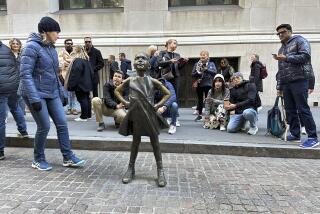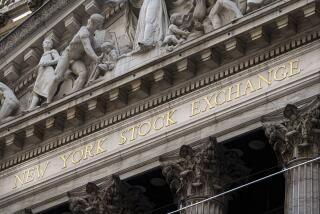Junk Bonds Are Hot, but So Is Money Fueling the Rally
- Share via
The corporate junk bond market scored its biggest monthly gain in at least a decade in February, as speculative money poured into the high-yield issues.
The First Boston Corp. index of 350 junk bonds posted a total return of approximately 8.6% for the month, the firm said. That followed a total return of 2.7% in January, bringing the year-to-date gain to 11.6%.
In contrast, the Dow Jones industrial average has risen 9.4% so far this year. So junk is handily beating the Dow’s mini bull market. Other brokerages’ junk bond indexes show varying returns for February, but the trend in every case is dramatically higher.
The 11.6% average total return so far this year--a combination of interest earned on the bonds and their change in price during the period--contrasts with a negative total return of 6.4% for all of 1990. Junk bond prices plunged last year as investors saw the unfolding recession as a death blow for many heavily indebted companies.
Now some buyers believe that the recession is nearing an end and that many junk companies will see their bonds soar in value as it becomes clearer that the firms will survive--and thus that they’ll continue paying the high interest on their bonds.
“The attitude had been, if any (company) had problems, it was going under. Now the attitude is, if any company has a shot (at surviving), it’s going to make it,” says David Feinman, a junk bond trader at brokerage Jefferies & Co. in Los Angeles.
But junk bond experts warn that, despite the intensity of the rally, most of the buyers so far are short-term speculators, or “hot money” players--not long-term investors. It’s dangerously premature to assume that junk bonds are in a sustained recovery from their three-year depression, experts say, because the speculators could bolt the market at any moment.
Who says it’s all one big speculation at this point?
* Bill Veronda, who manages the Financial Programs High-Yield bond mutual fund in Denver, has seen his fund mushroom to $49 million from $39 million a few months ago. “It’s all hot money--I know them by name,” says Veronda. “There is no meaningful component of long-term investors buying now.”
* At Fidelity Investments in Boston, spokesman Neal Litvack describes the doubling of the firm’s Spartan High Income bond mutual fund assets, to $40 million this month, as a product of “the hottest of the hot money.”
* Junk trader Feinman at Jefferies & Co. says the rally’s tentative nature is evident in the buying patterns of bond mutual fund managers, such as Veronda. Forced to put their sudden cash inflows to work, they’re buying only the “creme de la creme” of junk bonds, such as issues from debt-heavy yet still healthy firms like RJR Nabisco and Duracell, Feinman says. That way, if the hot money turns and runs, the bonds can be sold with relative ease.
* The junk bonds that gained the most in February were the most speculative types, such as zero-coupon bonds and bonds that are in default.
The message here is that investors who are thinking about buying junk bonds for the long haul--on the assumption that the bonds have bottomed--still are in the minority. So the bonds’ prices are totally at the mercy of the speculators, who might decide to make a capital gain of 20% or so and then exit in a hurry.
Likewise, if you’ve been stuck in a junk bond mutual fund for years and hope to sell if you get back to even, you may get your chance soon. But the opportunity could come and go in a flash if the economy in fact doesn’t emerge from recession soon after the end of the Persian Gulf War. Another surge of corporate bankruptcies could cause junk players to abandon all hope.
Even so, some junk analysts say investors shouldn’t underestimate the force of the rally thus far--and how much further it may run. Joseph Bencivenga, high-yield-bond chief at Salomon Bros. in New York, notes that the junk market has rallied even as the Federal Deposit Insurance Corp. has been dumping $150 million a week in junk bonds owned by now-defunct S&Ls.;
A number of big junk issuers also have become takeover targets recently, and the acquirers have offered substantially more for the targets’ junk bonds than what the market assumed was likely, Bencivenga notes. Hasbro Inc.’s planned purchase of troubled Tonka Corp. is a good example of that. And Thursday, rumors that Procter & Gamble is planning to buy debt-heavy Revlon Inc. sent Revlon’s bonds soaring.
But for the rally to extend much further, long-term investors will have to join the speculators, many analysts argue. And despite junk bonds’ stratospheric yields--the average annualized yield of bonds in the First Boston index now is 16.7%, down from 18.4% in January--many investors refuse to bite.
Fidelity, for example, finds that most of its investors are still concerned with quality and safety in bond investments, Litvack says. They’re sticking with U.S. Treasury bond funds yielding around 8%--evidently figuring that, after all of the junk bankruptcies of recent years, a safe 8% is better than a 16.7% that could turn into zero.
Briefly: Investment banker Goldman, Sachs & Co. shocked Wall Street when it bought the entire $1.26-billion California state general-obligation bond issue on Wednesday. Goldman says it already has placed all of the nine- to 18-year bonds with investors. But it still has $380 million of two- to eight-year, 19-year and 20-year issues to sell--which may not be a picnic for Goldman, as market interest rates continue to rise. “We’re still encouraged,” says Goldman banker Edward Droesch in New York. “We knew it would take a lot of time.”
The four-year bonds, as an example, yield 5.2%, which is exempt from federal and state income tax. That’s equivalent to an 8% taxable yield for someone in a combined federal and state tax bracket of 35%. The 20-year bonds yield 6.65%, worth 10.2% to a 35%-bracket taxpayer. Most brokers can get the bonds for you, via Goldman . . .
Corporate insiders, who had been wildly buying their own companies’ shares all through the market’s plunge in the fall, now are heavy sellers. The Insiders newsletter of Ft. Lauderdale, Fla., says its “Flash Index” of corporate insiders’ trades--measuring open-market trades executed in the previous 30 days--fell to 43% in the reading last week. That means only 43% of the trades were purchases, while 57% were sales.
When the market was bottoming last fall, the Flash Index had reached a record 90%, meaning that nine out of 10 insiders were buying their own stocks. Now, with the market near all-time highs, many insiders apparently believe their stocks no longer are bargains. That’s often a good hint for the rest of us . . .
Another sign that the market may be near at least a short-term top: The Investors Intelligence weekly survey of non-brokerage investment advisers (mostly newsletter writers) shows 58.6% now bullish, the highest percentage since 1987. The bears total 29.3% of those surveyed, and the other 12.1% expect just a normal correction ahead. Often, a strongly bullish reading indicates that too many advisers have already joined the party--and that there aren’t enough people with cash left to buy, leaving the market vulnerable to a selloff. However, if this is truly a bull market, the bullish percentage can get much higher before the market tanks. The bullish reading was 64.6% in January, 1987--at the start of a seven-month market surge.
JUNK BONDS ON A TEAR The total return of First Boston Corp.’s junk bond index was 8.6% in February--a record high for any month. How monthly returns have fluctuated:
Source: First Boston
1990
Jan. -3.5%
Feb. -1.9%
March +2.9%
April +0.4%
May +2.1%
June +3.2%
July +3.2%
Aug. -4.6%
Sept. -7.6%
Oct. -2.5%
Nov. +2.0%
Dec. +0.5%
1991
Jan. +2.7%
Feb. +8.6%
THURSDAY’S JUNK BOND STARS Some of the big gainers among corporate junk bond issues on Thursday:
Maturity/ Price and Current Issuer coupon change* yield Chrysler 1997/13% $770,+$56 16.9% Kerr Glass 1996/13% $870,+$5 14.9% Maxxam 1999/12 1/2% $815,+$15 15.3% Pan Am 2003/13 1/2% $91,+$10 -- Revlon Inc. 1995/11 3/4% $880,+$41 13.4% RJR Nabisco 2001/13 1/2% $1,060,+$5 12.7% TWA 1994/15% $389,+$19 --
* price per $1,000 face value
Source: Reuter
More to Read
Inside the business of entertainment
The Wide Shot brings you news, analysis and insights on everything from streaming wars to production — and what it all means for the future.
You may occasionally receive promotional content from the Los Angeles Times.










